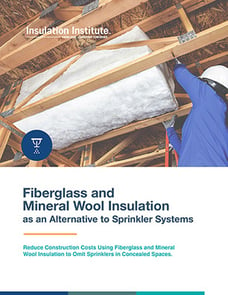According to the Fire Protection Research  Foundation, the median cost of a residential sprinkler system is $5,000, but the maximum cost of a system averages $21,000. Those are huge numbers that contribute to the builder’s total cost of construction. Builders may be able to cut their overall costs for sprinklers by using fiberglass and mineral wool insulation as an effective, affordable passive fire protection solution in concealed spaces and ceiling cavities in low-rise buildings and one and two-family dwellings. NAIMA has released a new publication detailing the new provisions of the 2019 National Fire Protection Association (NFPA) Standard 13 on when sprinklers may be omitted.
Foundation, the median cost of a residential sprinkler system is $5,000, but the maximum cost of a system averages $21,000. Those are huge numbers that contribute to the builder’s total cost of construction. Builders may be able to cut their overall costs for sprinklers by using fiberglass and mineral wool insulation as an effective, affordable passive fire protection solution in concealed spaces and ceiling cavities in low-rise buildings and one and two-family dwellings. NAIMA has released a new publication detailing the new provisions of the 2019 National Fire Protection Association (NFPA) Standard 13 on when sprinklers may be omitted.
Fiberglass and Mineral Wool as Passive Fire Protection
Fire protection in building codes includes three primary elements: detection, suppression, and containment. Balanced fire protection design blends fire detection (e.g., fire alarm systems) with active fire suppression (sprinkler systems) and passive measures such as fire-resistive building materials, like fire blocking, firestopping, fire-rated floors, walls, and doors. Fiberglass and mineral wool insulation can also be used as passive fire protection systems because they are noncombustible materials that can contain or slow the spread of fires.
Fiberglass, rock and slag wool insulation are ideally suited for passive fire protection and are a flexible, low-cost alternative to sprinkler systems in concealed spaces where fire and smoke could otherwise progress through a building. NAIMA’s guide contains an overview of when and where sprinklers may be omitted and how the space must be built to comply with NFPA Standard 13 requirements. The publication also details how sprinkler piping may be protected using fiberglass and mineral wool insulation in unconditioned areas.
Builders should have their design reviewed and approved by a knowledgeable design professional and a local building official to ensure compliance with local codes and standards.





